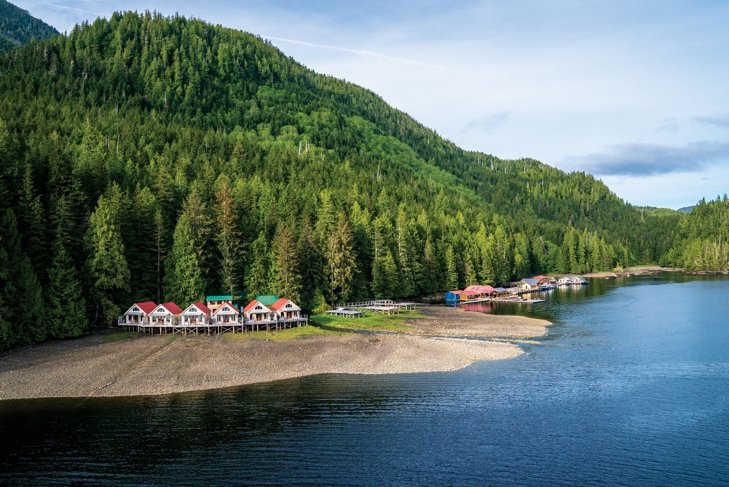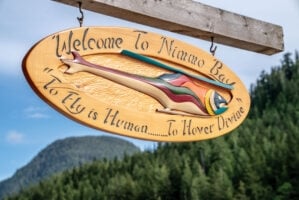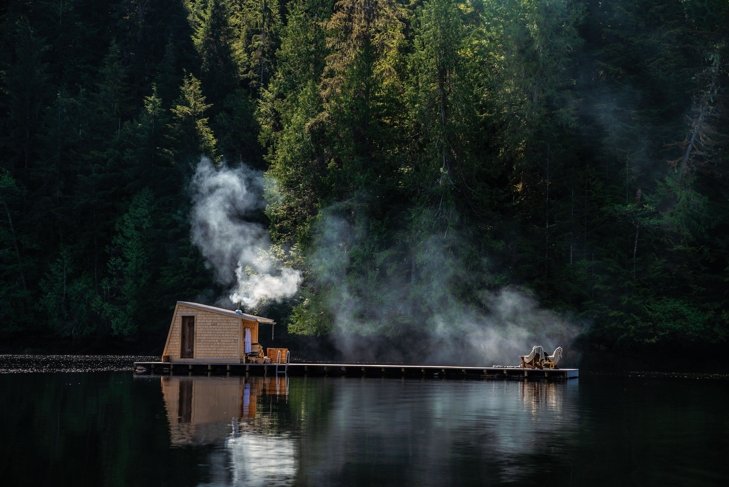
 I’m in a shallow-bellied boat racing up a green river. Lush trees lean in from both banks. Eagles perch like guards on the gnarled, sculptural roots of uprooted trees, watching the boat whip by. The river is dotted with obstacles—logs jutting up at odd angles, divots in the water that signal some mystery danger just beneath the surface—but the guide at the helm dodges them expertly, as if following a line on the river only he can see.
I’m in a shallow-bellied boat racing up a green river. Lush trees lean in from both banks. Eagles perch like guards on the gnarled, sculptural roots of uprooted trees, watching the boat whip by. The river is dotted with obstacles—logs jutting up at odd angles, divots in the water that signal some mystery danger just beneath the surface—but the guide at the helm dodges them expertly, as if following a line on the river only he can see.
It feels like we’re in the depths of a jungle. But instead of muggy air and glossy undergrowth, there’s a cool May breeze, and jagged mountains bristling with spruce and fir rear up beyond the river.
We’re in the temperate, 21-million-acre Great Bear Rainforest along Canada’s west coast. It runs from just north of Washington to the Alaska panhandle—a dense, mist-lashed forest that’s larger than Ireland. It houses bears, wolves and thousand-year-old trees. Its waters are the fringes of the Pacific Ocean: a dizzying maze of fjords and inlets. Whales, sea otters and porpoises swim in them.
My gateway to this hidden world—a whole 50,000 square miles of it? Nimmo Bay Wilderness Resort.
 Photo credits: Scott Yavis
Photo credits: Scott Yavis
Beyond the resort
Aside from the experiences it offers in house, Nimmo Bay partners with local First Nations—“supporting their businesses and their traditional territory and recognizing that,” says Murray. And he’s always looking to do more.
That’s why, in addition to a longstanding partnership with Sea Wolf Adventures, Nimmo Bay recently partnered with a new guiding outfit, Raven Adventures, run by Hemajlas Deedames Willie and Thomas Peter Moon of the Dzawada’enuxw First Nation. The nearby village of Gwayi – Kingcome Inlet is the main village site of the Dzawada’enuxw. It’s only reachable by boat or seaplane—and Raven Adventures has access to it.
Willie hopes tourism will grow into a significant source of employment for the Dzawada’enuxw First Nation and benefit the neighboring Gwawaenuk Tribe and Kwikwasut’inuxw Haxwa’mis First Nation too.
“Now we can actually do something that’s sustainable and will have a long-term life,” Willie says. “We can look forward to seeing [tourism] in 10, 15, 20 years and what it can be.”
River, land and sea
It’s thanks to Raven Adventures that I find myself jetting along the Kingcome River that spring afternoon toward the village of Gwayi – Kingcome Inlet. Willie helms the boat, while Moon sits nearby, pointing out the many places where he’s had close calls with bears. A mountain bluff where one chased him. A clearing where he nearly stepped on a sleeping bear. He doesn’t resent the creatures—far from it. He has named every bear in the area.
Before the day is over, I’ll stand in the dark, earthy stillness of a Bighouse in the village. Eat a gourmet picnic on the riverbank. Gasp at Lacy Falls: thin sheets of water cascading down a rock face that really do look like endless, scalloped rows of lace slipping into the ocean. Laugh at sea lions lounging and squabbling. Watch Pacific white-sided dolphins carve their way through our wake. And when I’m back at Nimmo Bay that night, seated on the floating fire dock with the forest at my back and the still bay before me, I’ll remember Moon’s words.
“I’ve got to have the trees around me. I’ve got to have the water.”

The OG ecolodge
Ever since the main lodge was first towed into the bay in 1981, Nimmo Bay Wilderness Resort has minimized its footprint on the surrounding wilderness. Because most buildings are floating or built on a rocky outcrop, the resort has had little effect on the forest habitat at the base of Mount Stephens.
The resort is built around a waterfall—its source of clean energy. It thoroughly treats its wastewater before sending it into the sea. No toxic chemicals are used to preserve the chalets’ wooden siding. And as much found wood as possible is burned in fireplaces (instead of cutting down living trees).
But the greatest sustainability challenge happens off site. Guests come from all over the world to stay here. Most fly to Vancouver Island and then take a 20-minute floatplane ride to the resort.
“The biggest carbon footprint is just getting here,” Murray says. Travel makes up 55 percent of the resort’s total footprint and is roughly equivalent to the emissions from 158 cars per year. He plans to offset this and make Nimmo Bay carbon negative by 2025.
Luxury with an edge
Nimmo Bay has been billed as many things. An intimate, family-run ecolodge. A remote luxury resort. None of those definitions captures its essence. This isn’t a quaint operation, and it’s not a palatial outpost. It’s luxurious, but not in a way that cocoons you in creature comforts, turning nature into a postcard. It doesn’t shave all the rough edges off the wilderness for you. Instead, it lets you stand on those edges every day of your stay, and then brings you back to a haven that’s both unfussy and world class.
“I think luxury these days is defined more by time and experience and intimate moments,” says Fraser Murray, Nimmo Bay’s part-owner and chief operator. “Luxury here is not gold marbles and dancing bears.”
Luxury here is kayaking through mist and silence. It’s feeling the cool spray of a waterfall on your face as you soak in the warmth of a hot tub. It’s heli-adventures that run you from relentlessly green valleys up to snow-capped peaks and ancient glaciers. Early morning yoga and freshly baked treats from the floating “bay-kery.” Whale- and bear-watching. Dining on charred eggplant with spruce tips and a watercress reduction. Guided hikes, paddleboarding … all from a resort with just nine chalets and a capacity of 18 to 24 guests.
Every one of those experiences is expansive—deep and wide and often profound. They allow you to go further into the wilderness than you’ll likely go again, and deeper into yourself.
A deep dive into wellness
Recently, Nimmo Bay added a wellness experience to its offerings. Cheryl Davidson, a massage and wellness therapist who helped develop the program, says the setting is key.
“Just being in this space with the grandeur of nature and all the animals, you feel small, but also you become really aware of aspects outside of yourself. It just shifts your perspective deeply, which allows for perspective shifts in all aspects of your life,” says Davidson. “This is a powerful spot.”
That’s clear from the moment I arrive by boat at a secluded floating dock one bay over from the main resort. The session begins with a meditation and a consultation with Davidson in sun-splashed Adirondack chairs. She covers everything from emotional to spiritual health in surprising depth. Then I head to the sauna at the edge of the dock for heat and solitude and an uninterrupted view of Mount Stephens across the bay, punctuated by dips in the cold, still water that surrounds us.
We boat back to the main lodge and the resort’s outdoor rain shower, where a eucalyptus and sea salt scrub awaits. Then it’s up to the Cascade Room, a place of windows and light perched next to the waterfall at the heart of the resort. I sip an elderflower and kale smoothie and parsnip-chaga soup, listening to the sound of water fanning over rocks. That sound permeates nearly every corner of the resort, but it’s especially close here.
The experience ends with a massage, energy work and intuitive guidance. Yes, it’s relaxing. More importantly, it’s revealing. After the closing meditation, I feel like I’m surfacing.
Vanessa Annand is alive’s managing editor. She and alive photographer Scott Yavis were hosted by Nimmo Bay Wilderness Resort for four days in May.











